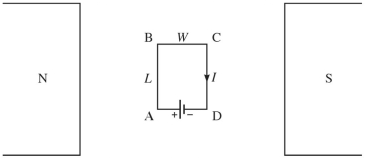A flat rectangular loop of wire is placed between the poles of a magnet, as shown in the figure. It has dimensions and , and carries a current in the direction shown. The magnetic field due to the magnet is uniform and of magnitude . The loop rotates in the magnetic field and at one point the plane of the loop is perpendicular to the field. At that instant, what is the magnitude of the torque acting on the wire due to the magnetic field?
Definitions:
Q4: An object is placed to the left
Q11: Two long parallel wires are placed side-by-side
Q64: What do we mean when we say
Q95: Doubling the potential across a given capacitor
Q111: A soap bubble has an index of
Q148: An object is placed 10 cm from
Q148: After landing on an unexplored Klingon planet,
Q160: In an RLC ac circuit, the values
Q163: A long, straight, horizontal wire carries current
Q373: Seven seconds after a brilliant flash of